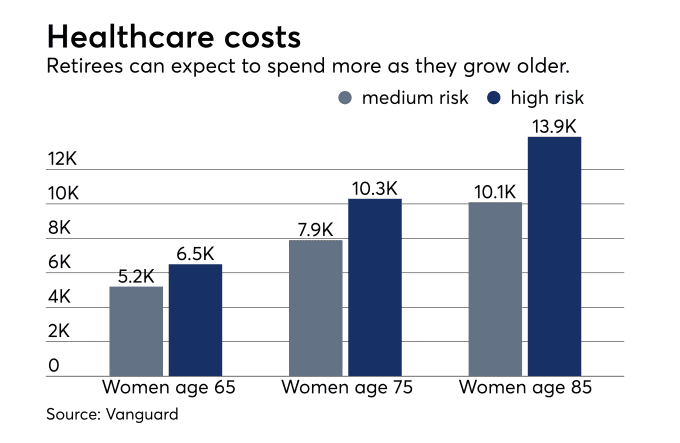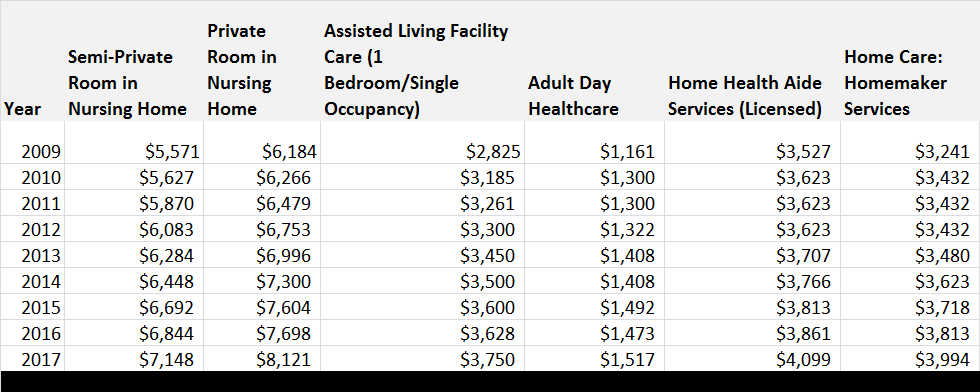Unsure About the Annual Cost of Healthcare in Retirement? Here’s Why It Matters

Have you heard that the average retiree couple may pay as much as $280,000 in total healthcare costs in retirement? That certainly is a big price tag to mull over. And as Vanguard notes in a recent report, cost-of-retirement-healthcare estimates as a lump sum often keep people in a stop-and-shrug zone.
Such a substantial sum seems hard to account for. Not only that, a number of national healthcare cost surveys leave out the costs of long-term care in their estimates. Others treat long-term care as a separate area of expenses from retirement health costs. Either way, many Americans don’t know where to even start with planning for potentially high-cost health events during their golden years.
Well, here’s some good news: planning for retiree health and long-term care costs is well within reach. In that Vanguard report, researchers found a more palatable way for educating people to take action about their retirement health needs: framing healthcare costs as annual expenses, not as a substantial lump sum.
Costs of Retirement Healthcare: An Annual vs. Cumulative Look
In its research, Vanguard engaged Mercer Health and Benefits to develop a new model to forecast healthcare costs for U.S. retirees.
“We believe that a better planning framework considers these costs as annual expenses personalized to an individual’s health status, coverage choices, retirement age, and loss of any employer subsidies. For a typical 65-year-old woman, the Mercer-Vanguard model predicts an annual healthcare expense of $5,200 in 2018,” according to the report.

Attribution: BIC.FinancialPlanning.com, Vanguard, Planning for Health Care Costs in Retirement.” Source link, all rights reserved.
This estimate supposes she has Medicare Supplemental Plan F coverage and a standard prescription drug plan. It doesn’t include long-term care or supports costs.
Benefits of a New Perspective
According to the report, the new Mercer-Vanguard model is notable for several reasons:
- It suggests that projecting healthcare costs as a lump-sum is intimidating for many retirement savers, which can frighten them into inaction.
- It makes the process of planning for healthcare in retirement more feasible and manageable.
- It gives more insights into how to plan for healthcare for all households, from single and divorced retirees to married retired couples.
- It separates long-term-care costs from other costly health expenses, so they can each be addressed.
- “Long-term care costs represent a separate planning challenge given the wide distribution of potential outcomes,” the researchers say.
Interestingly, the Vanguard research findings on long-term care needs differ considerably from the findings of other organizations.
Take, for example, recent research from the U.S. Administration on Aging, which reports that most Americans (52%) will need long-term care at some point-of-life. Here, Vanguard found that a less than one-quarter of its surveyed persons would pay less than $100,000 in long-term care expenses.
“Half of individuals will incur no long-term care costs—but there is a small but meaningful risk that costly care will be required for multiple years,” according to the Vanguard report. And what is the share of those expected to spend in excess on long-term care? 15% of those surveyed, says Vanguard.
For those curious about what long-term care services might cost – here are actual median costs of different LTC services and supports nationally, courtesy of insurance carrier Genworth.

Source: Created by SafeMoney.com, data from Genworth Cost of Care surveys 2009-2017. Source link – All rights reserved.
Individual Results May Vary
Of course, that said, healthcare costs are as individual as we are.
When creating a retirement and financial plan to address ways to prepare for potential costs, there are a number of factors to consider. According to the Mercer-Vanguard model, these variables include:
- Your health status and risk profile,
- the Medicare coverage you choose,
- Your retirement age,
- Where you live,
- Any employer subsidies if you are still working, and
- Anticipated Medicare surcharges for higher-income households.
The combination of these factors should influence a worker’s rate of savings for retirement and healthcare costs, the report says.
Perhaps the most significant among these is your personal and family health history. “Certain health conditions have more impact on future healthcare costs, and most chronic conditions will have manifested symptoms by one’s 50s or 60s,” according to the study.
Smoker status and number of doctor visits were factors chosen to classify risk.
Based on a mix of “prevalence and cost” from chronic-condition data provided by the Centers for Medicare and Medicaid Services (CMS), the Mercer-Vanguard model chose 12 conditions, from heart disease to Alzheimer’s, as a base to establish a retiree’s likely health status.
They included both the individual’s medical history and parental medical history.
3 Different Levels of Risk
The Mercer-Vanguard healthcare cost model divides people into three risk categories: high, medium, and low.
In their estimation, high-risk individuals in their model are smokers, people who visit the doctor frequently, or have two or more of the 12 chronic conditions. Then comes medium-risk individuals and low-risk individuals, who are usually free of chronic conditions.
“During their working years, some individuals should save at higher rates to account for potential future incremental healthcare spending,” the report advises.
“Workers with generous employer health care benefits that may not be offered in retirement and those at higher risk of chronic conditions because of their family history or current health status should target higher replacement ratios,” it adds.
Retirees and working-age Americans will want to consider individual financial strategies for combating high-cost healthcare expenses — like potentially having a set-aside sum of liquid reserves — and don’t forget to consider long-term care strategies, as well!
After all, having to liquidate assets to pay for sudden health needs could trigger an unexpected or substantial tax bill.
Encouragement to Stop Shrugging, Start Planning
“Most analyses available today point to a daunting out-of-pocket health-care expense over the lifetime of a retiree,” according to Jean Young, co-author and senior research associate in the Vanguard Center for Investor Research.
“These large dollar values can be demotivating for investors from a psychological and behavioral perspective. Instead, our model focuses on the more manageable task of planning for incremental, annual healthcare costs, while separately considering and integrating the potential for long-term care expenses.”
Getting Your Own Retirement Financial Plan in Shape
You may have a gameplan for your retirement financial future. But are you confident in whether you are ready for the often-high-cost of long-term care or other health events in retirement? Nothing is foolproof, but a well-thought-out strategy for health needs can go a long ways toward enjoying a financially secure retirement lifestyle.
If you are ready to create a strategy — or you believe you can do more — financial professionals at SafeMoney.com stand ready to help you. Use our “Find a Financial Professional” section to connect with someone directly. Should you need a personal referral, call us at 877.476.9723.








